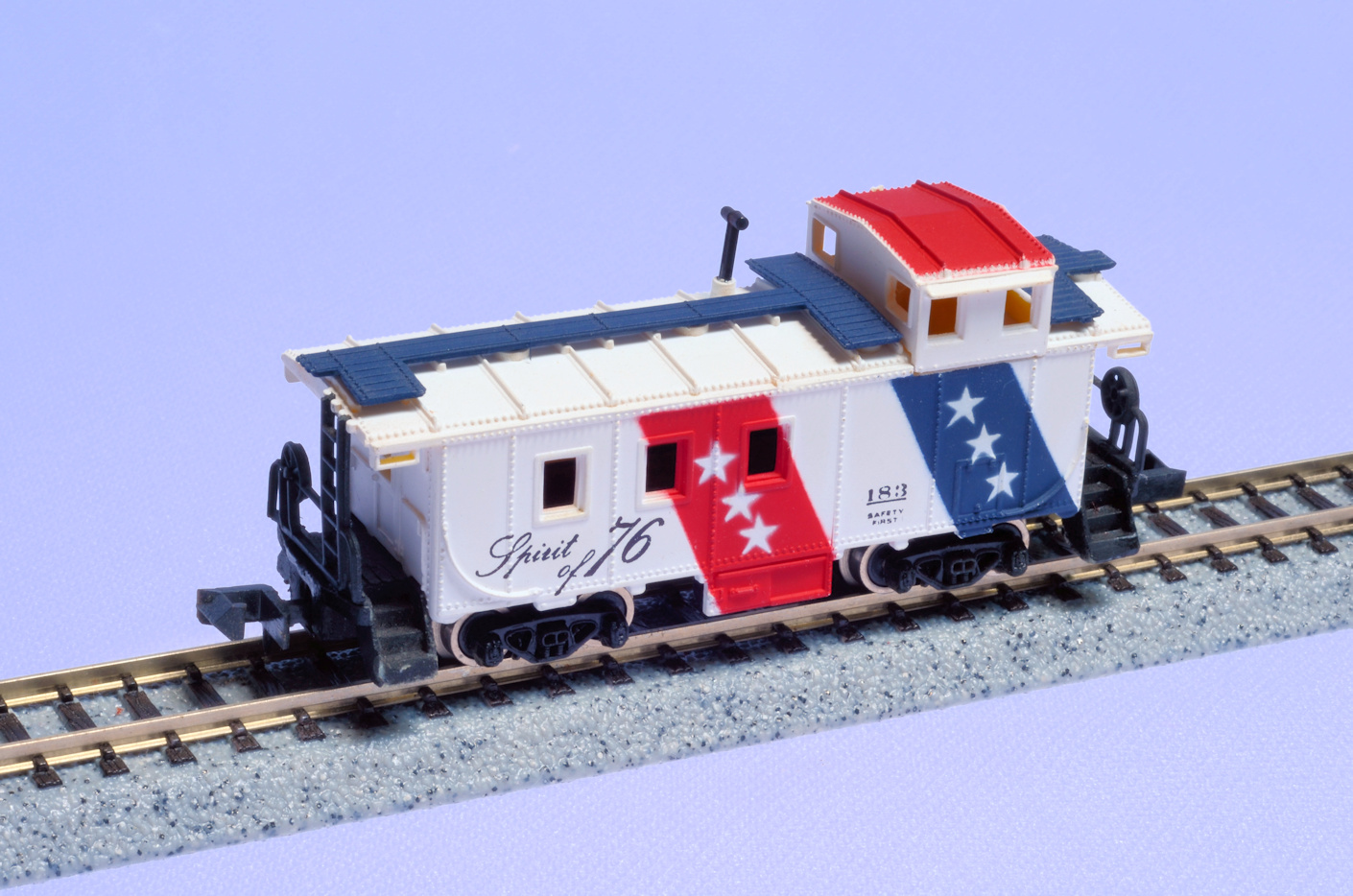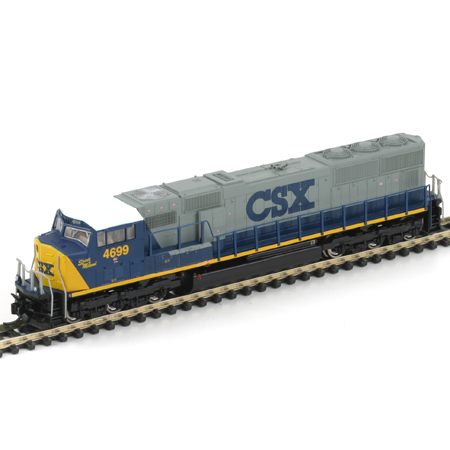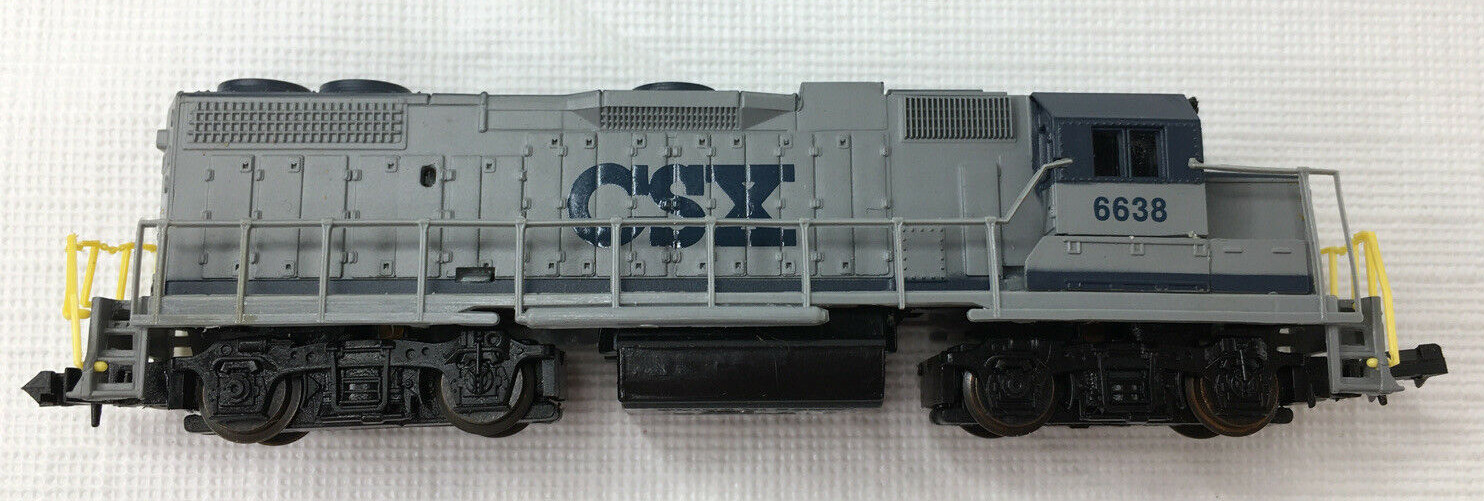Model Information: This model was introduced sometime around 1960 by Lone Star trains of Great Britain. They use a bizarre mechanism that employs a rubber band to transfer traction from the motor to the wheels. They don't run very well and furthermore the rubber bands decay and need to be periodically replaced. They have hefty diecast metal bodies.
Stock numbers for motorized versions start by "EL"; they are branded "Treble-O-lectric". Non motorized version are branded "Treble-O-Trains".
Stock numbers for motorized versions start by "EL"; they are branded "Treble-O-lectric". Non motorized version are branded "Treble-O-Trains".
DCC Information: DCC? Nope.
Prototype History: The F7 was the fourth model in GM-EMD's successful line of F unit locomotives, and by far the best-selling cab unit of all time. In fact, more F7's were built than all other F units combined. It succeeded the F3 model in GM-EMD's F unit sequence, and was replaced in turn by the F9. Final assembly was at GM-EMD's La Grange, Illinois, plant or GMD's London, Ontario, facility.
The F7 differed from the F3 primarily in internal equipment (mostly electrical) and some external features. Its continuous tractive effort rating was 20% higher (e.g. 40,000 lb (18,000 kg) for an F7 with 65 mph (105 km/h) gearing, compared to 32,500 lb (14,700 kg) for an F3 with the same gearing.
A total of 2,366 cab-equipped lead A units and 1,483 cabless-booster or B units were built. (Note: the B unit is often referred to as an "F7B", whereas the A unit is simply an "F7".)
Many F7s remained in service for decades, as railroads found them economical to operate and maintain. However, the locomotive was not very popular with yard crews who operated them in switching service because they were difficult to mount and dismount, and it was also nearly impossible for the engineer to see hand signals from a ground crew without leaning way outside the window. As most of these engines were bought and operated before two-way radio became standard on most American railroads, this was a major point of contention. In later years, with the advent of the "road switchers" such as the EMD GP7, F units were primarily used in "through freight" and "unit train" service where there was very little or no switching to be done on line of road.
From Wikipedia
Read more on American-Rails.com
The F7 differed from the F3 primarily in internal equipment (mostly electrical) and some external features. Its continuous tractive effort rating was 20% higher (e.g. 40,000 lb (18,000 kg) for an F7 with 65 mph (105 km/h) gearing, compared to 32,500 lb (14,700 kg) for an F3 with the same gearing.
A total of 2,366 cab-equipped lead A units and 1,483 cabless-booster or B units were built. (Note: the B unit is often referred to as an "F7B", whereas the A unit is simply an "F7".)
Many F7s remained in service for decades, as railroads found them economical to operate and maintain. However, the locomotive was not very popular with yard crews who operated them in switching service because they were difficult to mount and dismount, and it was also nearly impossible for the engineer to see hand signals from a ground crew without leaning way outside the window. As most of these engines were bought and operated before two-way radio became standard on most American railroads, this was a major point of contention. In later years, with the advent of the "road switchers" such as the EMD GP7, F units were primarily used in "through freight" and "unit train" service where there was very little or no switching to be done on line of road.
From Wikipedia
Read more on American-Rails.com
Road Name History: The Union Pacific Railroad (reporting mark UP) is a freight hauling railroad that operates 8,500 locomotives over 32,100 route-miles in 23 states west of Chicago, Illinois and New Orleans, Louisiana. The Union Pacific Railroad network is the largest in the United States and employs 42,600 people. It is also one of the world's largest transportation companies.
Union Pacific Railroad is the principal operating company of Union Pacific Corporation (NYSE: UNP); both are headquartered in Omaha, Nebraska. Over the years Union Pacific Corporation has grown by acquiring other railroads, notably the Missouri Pacific, Chicago & North Western, Western Pacific, Missouri-Kansas-Texas, and the Southern Pacific (including the Denver & Rio Grande Western).
Union Pacific Corporation's main competitor is the BNSF Railway, the nation's second largest freight railroad, which also primarily services the Continental U.S. west of the Mississippi River. Together, the two railroads have a duopoly on all transcontinental freight rail lines in the U.S.
Read more on Wikipedia and on Union Pacific official website.
Union Pacific Railroad is the principal operating company of Union Pacific Corporation (NYSE: UNP); both are headquartered in Omaha, Nebraska. Over the years Union Pacific Corporation has grown by acquiring other railroads, notably the Missouri Pacific, Chicago & North Western, Western Pacific, Missouri-Kansas-Texas, and the Southern Pacific (including the Denver & Rio Grande Western).
Union Pacific Corporation's main competitor is the BNSF Railway, the nation's second largest freight railroad, which also primarily services the Continental U.S. west of the Mississippi River. Together, the two railroads have a duopoly on all transcontinental freight rail lines in the U.S.
Read more on Wikipedia and on Union Pacific official website.
Brand/Importer Information: Lone Star was founded by Aubrey Robert Mills and Sidney James Ambridge in 1939 as the toy division of Die Casting Machine Tools Ltd. (DCMT) of London. DCMT was manufacturing diecasting machines and equipment. DCMT had made some toy cars for Crescent, and diecast toy cap-firing guns, which DCMT supplied under the "Lone Star" brand. "Lone Star" was a name that conjured up images of the Wild West, and while it was a reference to the Texas state flag (with its single star), the name also reminded children of the star-shaped Sheriff's badge that was often a key part of a cowboy costume.
Lone Star Locos appeared in the late 1950s as a range of fairly basic 000-scale diecast miniature trains and track, and were joined in the 1960s by the comparatively short-lived "Treble-O-Lectric" range of "proper" motorised 000-scale electric train sets. The motorised range was discontinued circa 1965. DCMT ceased its operation circa 1988.
The Lone Star Treble-O (triple O) rolling stock was scaled to 2mm to the foot (1:152) and track's gauge was 9mm.
Lone Star paved the way to the N scale model trains that would be soon after introduced by Arnold Rapido.
Read more on Irwin's Journal and on The Brighton Toy and Model Index.
Lone Star Locos appeared in the late 1950s as a range of fairly basic 000-scale diecast miniature trains and track, and were joined in the 1960s by the comparatively short-lived "Treble-O-Lectric" range of "proper" motorised 000-scale electric train sets. The motorised range was discontinued circa 1965. DCMT ceased its operation circa 1988.
The Lone Star Treble-O (triple O) rolling stock was scaled to 2mm to the foot (1:152) and track's gauge was 9mm.
Lone Star paved the way to the N scale model trains that would be soon after introduced by Arnold Rapido.
Read more on Irwin's Journal and on The Brighton Toy and Model Index.
Item created by: CNW400 on 2020-06-14 19:58:34. Last edited by CNW400 on 2020-06-14 19:58:35
If you see errors or missing data in this entry, please feel free to log in and edit it. Anyone with a Gmail account can log in instantly.
If you see errors or missing data in this entry, please feel free to log in and edit it. Anyone with a Gmail account can log in instantly.











